A DAY WITH THE GEAR-JAMMERS
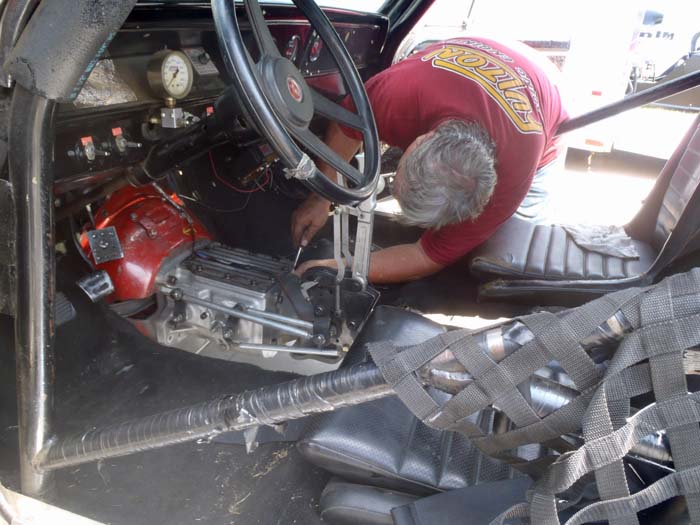
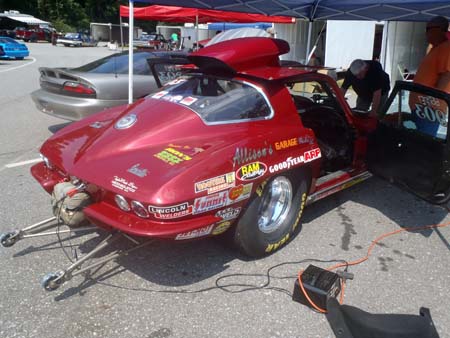 JUST LIKE OLD TIMES - Quain Stott admits he makes a terrible spectator.
JUST LIKE OLD TIMES - Quain Stott admits he makes a terrible spectator.
Yet, on Saturday evening at Greer Dragway, the professional drag racer from Inman, South Carolina was as happy as could be just watching a style of racing which took him back to the formative years of his career. It was as if he was back at the old Spartanburg Dragway off of Highway 221 in the small community of Roebuck, SC.
Greer Dragway hosted the High Winding Gear Jammers, the same type of stick shifted car which used to leave the Spartanburg Dragway starting line at nearly 10,000 rpm.
“I love this old stick shift stuff,” said Stott, who is one of the 12 former world champions to race at Spartanburg. “Close my eyes and it’s just the way it was back in the 1970s and 80s. I get to see a lot of people I haven’t seen in a while. It makes me feel like a kid.
“Blue collar racing is what you see here; there’s money tied up in these cars but not like those pro teams,” said Stott, referring to Greer Dragway's Saturday night featured sportsman event.
These kinds of cars were the kind you would see every first Saturday of the month at Spartanburg Dragway when the national tour didn’t have a conflicting race. The top series runners, including Spartanburg’s Gene Fulton, Bob Earnhardt of Roebuck and a score of other NHRA and IHRA Modified and Super Stock cars used to converge for a race before the hometown crowd.
Spartanburg’s Dane Pearson used to race in those combo events. He was also at Greer, with the same 1966 Corvette Stingray he debuted at Spartanburg Dragway in 1978.
“I love this kind of racing because all of these cars are stick and clutch cars,” exclaimed Pearson. “This is the way the racing started. If anyone came in with an automatic, everyone was laughing and wanted to race them because of the belief they couldn’t do anything – couldn’t get down the track. Today this automatic transmission technology has come a long way and now we are trying to keep up with them.”
Pearson said, back in the day, the competition at Spartanburg Dragway was just as tough as he’d see on the national tour.
“I have lots of good memories when it comes to racing at Spartanburg Dragway,” added Pearson. “When you beat the people at Spartanburg, you really did something. When you beat Gene Fulton there, you generally had enough thrill and emotion that it would carry you for the whole week.”
Todd Fox races the same 1962 Corvette his dad drove at Spartanburg Dragway. When his father Larry passed away in 2006, he took up driving the car and has kept it pretty much the same specs as when they raced in Spartanburg for the last time in 1981.
“Everything we did together was built around this car,” Fox explained. “I didn’t play football or baseball – I worked on the car with him. Most of our conversations usually centered around this car and pretty women.”
When it came down to it, for Stott and those who grew up in this form of racing, the cars didn’t hold a candle to the symphony a small block, manually shifted one belted out in the Carolina night.
“You can’t help but fall in love with it,” admitted Stott. “It winds up so high that it changes tunes three times before it leaves the starting line. They’d turn the stem-winding crap out of them. When it sounded like everything was going to come out the side of the engine was when they sounded the best. That’s what hooked me. It hooked a lot of other people too, look at all the people who came out to watch them.”
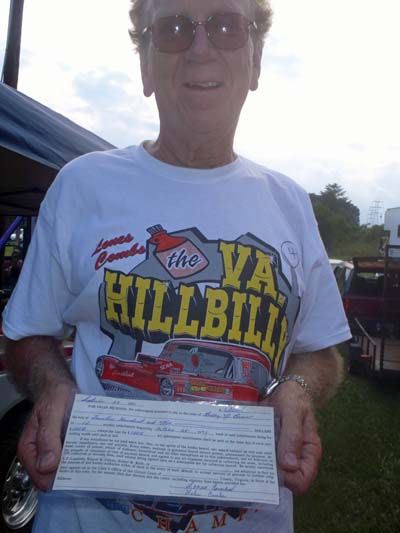 Former IHRA Modified racer Lones Combs proudly displays the original loan note where he purchased hisa 1957 ChevySHOEBOX DREAMS - At 63 years of age, Lones Combs has kept his 1957 Chevy almost as long as his wife Helen, his bride of 44 years. He clearly loves his wife first, and the classic four-speed car second.
Former IHRA Modified racer Lones Combs proudly displays the original loan note where he purchased hisa 1957 ChevySHOEBOX DREAMS - At 63 years of age, Lones Combs has kept his 1957 Chevy almost as long as his wife Helen, his bride of 44 years. He clearly loves his wife first, and the classic four-speed car second.
Next month will mark 41 years since Combs went to the bank and signed a promissory note to pay back a $1200 loan with payments of $100 monthly. Helen co-signed the loan and once he paid it off, the clear title remained in the car which he turned into a high-winding Modified car.
“I didn’t have any money, so I had to finance it,” Combs said, looking with pride at his bright orange shoebox turned classic gear-jammer.
Without doubt, the classic Chevrolet has proven to be the second love of his life.
“It’s exciting, I wind the rpms to about 10,000 and let the clutch out – and I feel 16 years old all over again,” admitted Combs. “There aren’t many things available that can do that to a man; if there is, it’s likely against the law.”
So enthused with racing his classic car, Combs ran everywhere he could in the 1980s including bracket races. His finest point was in 1983 when he represented his home track of Elk Creek Dragway in the bracket finals and beat out almost 800 other entries to reach the finals and win the Super Pro division. He nearly became the grand champion but broke out in the finals.
When he raced, he did so with a stick shifted car until the face of sportsman drag racing quickly changed.
Combs was one of the old Modified racers who found themselves looking for a place to race when Billy Meyer, then IHRA President in 1988, dropped class racing in favor of indexed-bracket racing. Combs joined the Sportsman Class Racers Association, a group formed in protest of the IHRA’s decision and raced there. When the SCRA folded, he found a home with the Gear Jammers circuit.
In 1989, Combs considered returning to the IHRA to race but quickly realized the series he left wasn’t the same he intended to run again.
“It’s all turned to automatics and not too hard to drive,” Combs explained. “Not many people like a challenge these days. Put that third pedal in there and it’s a handful.”
But for Combs, it’s a way of life, a tradition and a passion all rolled up into one.
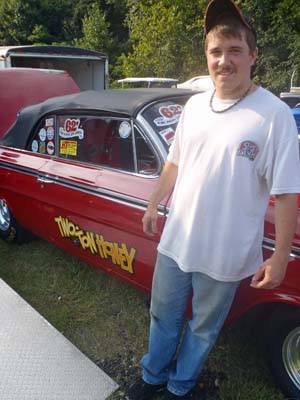 WORKS FOR GRANDPA, WORKS FOR ME - Mike Combs, 20, just might be an old soul trapped in a young body.
WORKS FOR GRANDPA, WORKS FOR ME - Mike Combs, 20, just might be an old soul trapped in a young body.
The up and coming driver on the High Winding Gear-Jammer circuit, a group comprised of stick-shift Modified style cars racing in the Carolinas and Virginia, pilots a 1963 Chevrolet Impala convertible.
Combs, the grandson of longtime Modified racer Lones Combs, drives the former Dolemite car, once a staple in IHRA Super Stock, rebranded as Two Ton Honey in tribute to Mike Phillips, who drove a similar car on the tour decades ago.
“When I turned 16, this became my first race car – never drove a junior or anything,” said Combs. “I got right in the car and drove.”
The Two Ton Honey designation might be a tribute, but for this upstart driver, there is truth in advertising.
“It’s 3,890 with me in it, not far from 4,000,” Combs proudly proclaims. “I was going to name it something else, but this is what Grandpa wanted. I was keen on ‘She’s fine my 409'.”
Combs then added, in the near future, his reference to the popular song wouldn’t be false advertising, even thought right now he is driving with a 350-incher under the hood which some refer to as a “junkyear motor.”
“We’re building one to go in here,” Combs said, his voice clearly running at the 409 speed.
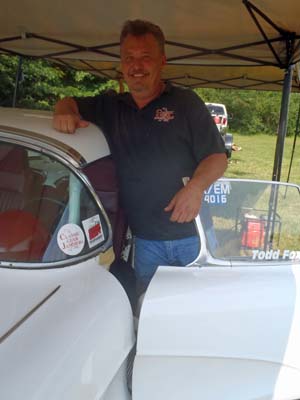 A FAMILY TRADITION AND A CORVETTE - You can faintly hear Hank Williams Jr., singing his famous tune A Family Tradition every time Burnsville, North Carolina's Todd Fox fires up his ex-Modified eliminator 1962 Corvette.
A FAMILY TRADITION AND A CORVETTE - You can faintly hear Hank Williams Jr., singing his famous tune A Family Tradition every time Burnsville, North Carolina's Todd Fox fires up his ex-Modified eliminator 1962 Corvette.
Fox, by his own admission, drives the same classic bowtie his dad Larry used to race as a Modified Production. And before it was raced on a track, the Corvette proved an efficient bootlegging vehicle in a dry county within the mountains of western North Carolina.
“Had it all of my life,” Fox, now 44, said proudly with a smile. “The best part of driving this car is all of the people who come up to me and tell me how they watched it when they were young. Their memories have made all of the work worth it.”
Memories and a seemingly ageless 1962 Corvette keep the second-generation stick-shift racer going in a straight-line.
Fox was in high school when his father went away on “business”, so in the meantime the car was stored away. On occasion, with a friend’s help, Fox would drag the old car out and get a tow around the neighborhood just to keep all the mechanical aspects in working order.
When Larry returned from “business”, the decision was made for the torch to be passed to the next generation.
Father and son went to the drag strip on the night before the father passed away. The first run didn’t produce the anticipated result.
“Broke a gear cluster,” Fox remembered. “I really got on him about it, cussed and hollered, ‘I thought you told me I wouldn’t break this thing.”
Still brandishing a smile of pride, Fox said his dad called him back the same night. Unfortunately It would be the last time the two spoke.
“He never said hello or anything, he wanted us to get together and go over the five-speed,” Fox said. “He told me I might break a cluster but I won’t break a gear. He knew I broke a cluster. He knew I broke it when I was doing a burnout on the street at the house.”
Dad had one last reminder for his son.
“He told me he could do burnouts on the street but I wasn’t to that level yet,” Fox added. “The last thing he said, ‘I’ll tell you one thing 'Big Todd', you’ll never do that again.”
Fox paused.
“And, I haven’t yet,” Fox said.
Fox admitted climbing behind the wheel after his father's passing was a tough, emotional decision. It was also a necessary one.
‘I was not a fan of driving and the first few times I got behind the wheel I wondered what I was thinking,” admitted Fox. “I would give anything to have him here – just to ask questions. I had my friends around me but they weren’t dad. I asked my buddy Tom Griffith if I should short shift it and he said just drive it through. I ran a 6.20 [eighth-mile] the first time I let the clutch out and came back the next run and ran a 5.90.”
The Corvette is nearly the same as it was when Larry ran strong in A/Modified Production and Fox still runs the trusty, yet antiquated Doug Nash 4+1 transmission.
“I’ve added anti-roll, coil-overs … which wasn’t legal back then,” Fox admitted.
Structurally the Corvette could easily be converted to street legal specs and become a Pro Street style car.
Fox wouldn’t dare consider it.
“A lifetime of driving this car around town couldn’t compare to one day at the strip,” Fox said with demeanor.
This didn’t mean the street-driven days of the pearl white Corvette didn’t leave more than a lion’s share of memories for Fox.
“I’ve been in the car at 170 mph with nine cases of beer, and 13 pints of liquor under the hood,” admitted Fox. “The car was pretty much stock but when it went through its vibration stage – it smoothed out and rode just fine.”
And just like life, when the vibration of its turmoil smoothed out, Fox and his father’s Corvette has run just fine.
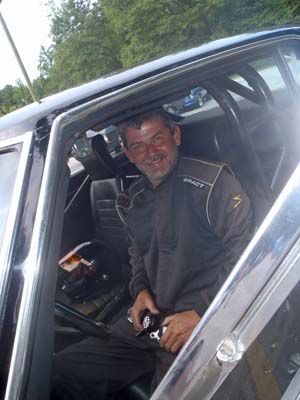 IT’S NOT AS EASY AS IT LOOKS - Stacy Hall has proven to be an efficient driver by keeping a good handle on a Top Sportsman car easily capable of four second eighth mile runs at over 180 miles per hour.
IT’S NOT AS EASY AS IT LOOKS - Stacy Hall has proven to be an efficient driver by keeping a good handle on a Top Sportsman car easily capable of four second eighth mile runs at over 180 miles per hour.
Hall, the lead foreman at Fulton Competition race engines, had his hands full Saturday with a car much slower and heavier than his bread winning quick doorslammer he races in ADRL competition.
Filling in for father-in-law Jimmy Flint, Hall behind the wheel of a Super Stock/E Modified 1967 Chevy II during Greer Dragway’s Gear Jammer event in Greer, SC.
It was like being a kid once again.
“I was around this kind of racing all of my life with Gene Fulton, my Dad and all of the guys out here racing,” admitted Hall. “I grew up around it.”
Yet, his hands were full keeping the stick-shifted Super Stocker in the groove. He was questioning his decision to drive the car after a couple of hands-full passes.
“My Top Sportsman or dragster … much easier cars to drive,” said Hall, a multi-time Top Sportsman national event winner. “You gotta pull, shift and everything … this is the real deal. It’s fun and I’m learning … getting better. It isn’t much different in hitting my shift points, except with the Top Sportsman … it’s pull, pull … pull. This car is push and pull.”
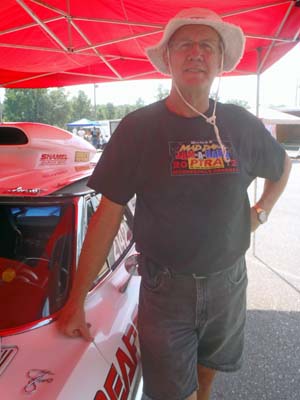 STILL A LOT OF FUN - Even though their actions might have justified imprisonment in the ‘what are you thinking jail’ to the chagrin of automobile enthusiasts, Dane Pearson and then partner Glenn Strange took a Saws-All to their newly purchased car some years ago.
STILL A LOT OF FUN - Even though their actions might have justified imprisonment in the ‘what are you thinking jail’ to the chagrin of automobile enthusiasts, Dane Pearson and then partner Glenn Strange took a Saws-All to their newly purchased car some years ago.
It was their car, and when the title is in your name – you can do most anything you want.
Let the record reflect, the car they chose to cut up and then rebuild into a race car was a 1966 Corvette Stingray hardtop convertible.
This unpardonable sin was committed in 1978.
“We cut all the rear end out from under it,” Pearson said with a fake grimace. “We cut the chassis apart and all of that kind of stuff. Of course, everyone told us how crazy we were. We just helped it out a bit. The car was headed downhill.”
Pearson’s downhill comments were in jest. But when you consider the car was of limited miles, his conversion was no laughing matter.
“The car was sold new in Spartanburg, still have the Burwell Chevrolet emblem for it,” Pearson proudly proclaims. “It’s an original, local one-owner car. We were the second owners, me and Glenn. It’s been a good car.”
Once Pearson and Strange finished their modifications they entered the car in the IHRA’s Formula 2 Modified Production classification where it fit into the “C” specification. Today the car is a legal NHRA Super Stock/D Modified entry.
Pearson now runs the car solo, without Strange, and while he understands the value the car and what it might have fetched on the open car collector market, his thought process hasn’t wavered since 1978. This car belonged on the drag strip.
“It makes a nice looking race car for sure,” Pearson said. “It would make a nice looking street car. I like street cars too. This is a neat little race car and easy to work on. Cobalts are great and have the latest technology, but this little car feels great … it doesn’t drive you, you drive it.”
Pearson primarily campaigns the car on the High Winding Gear Jammer circuit around the Carolinas and Virginia. Prior to the 1988 season, Pearson ran the IHRA tour religiously in Modified eliminator.
When Billy Meyer killed class racing during his ill-fated leadership in 1988, Pearson joined groups such as the Sportsman Class Racers Association and the Gear Jammers, choosing to race the way it used to be.
“When everything stopped for class racing, I got involved in the SCRA and we had a great following,” said Pearson. “The NHRA supported us and Dick Moroso was a big sponsor. This has always been about having fun.”
Pearson doesn’t need the big stage of championship drag racing to feed an ego. He gets a rush just racing closer to home on the local circuits.
One little tidbit Pearson relishes is he was featured in Issue No. 1 of the original Competition Plus magazine published in January 1988. Nearly 25 years later, he can add this feature to his scrapbook in the online version.
“It was a great honor to be in the printed version,” said Pearson. “I still have the copy and wouldn’t take anything for it. I’ll be looking forward to printing this version and saving it as well.”
All articles and photography published in CompetitionPlus.com are protected by United States of America and International copyright laws unless mentioned otherwise. The content on this website is intended for the private use of the reader and may not be published or reposted in any form without the prior written consent of CompetitionPlus.com.




































